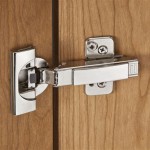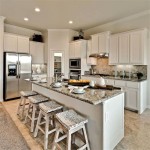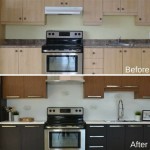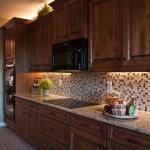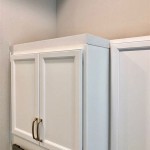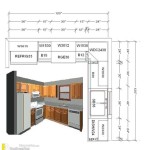Pictures of Kitchens with 2 Cabinet Colors: A Comprehensive Guide
The kitchen, often considered the heart of the home, is constantly evolving in design and functionality. One design trend gaining significant traction is the incorporation of two cabinet colors. This approach allows for greater personalization, visual interest, and the opportunity to define specific areas within the kitchen. Examining pictures of kitchens with two cabinet colors reveals a wide range of aesthetic possibilities, catering to diverse styles and preferences.
The implementation of two-toned cabinetry extends beyond mere aesthetics; it serves practical purposes as well. It can highlight architectural features, create a focal point, or effectively delineate workspace zones. Understanding the nuances of color selection, cabinet placement, and coordinating hardware is crucial for achieving a cohesive and impactful design. This article will delve into the various aspects of designing kitchens with two cabinet colors, providing insights and inspiration for homeowners and designers alike.
Understanding the Appeal of Two-Toned Kitchen Cabinets
The allure of two-toned kitchen cabinets lies in their ability to introduce depth, dimension, and personality into the space. Unlike monochromatic kitchens, which can sometimes feel flat or sterile, the use of two colors adds visual dynamism. This technique allows for a more nuanced expression of individual style and provides opportunities to create a kitchen that is both functional and aesthetically pleasing.
One key advantage is the ability to subtly define different areas within the kitchen. For example, a darker color on the base cabinets can ground the space and create a sense of stability, while lighter upper cabinets can visually expand the room and enhance the perceived height. Similarly, an island can be finished in a contrasting color to make it a focal point and delineate the cooking zone.
Furthermore, two-toned cabinetry offers flexibility in accommodating various design styles. From traditional and farmhouse kitchens to contemporary and minimalist spaces, the strategic use of contrasting colors can enhance the overall aesthetic. This adaptability makes it a popular choice for homeowners seeking to create a unique and personalized kitchen environment.
Pictures of kitchens with two cabinet colors showcase the diversity of design possibilities. They demonstrate how different color combinations, cabinet styles, and hardware choices can result in drastically different effects, ranging from bold and dramatic to subtle and sophisticated.
Key Considerations for Color Selection
Choosing the right color combination is paramount to the success of a two-toned kitchen design. The selection process should consider several factors, including the overall style of the home, the amount of natural light available, and the desired mood or atmosphere. It is crucial to create a harmonious balance between the two colors to avoid a jarring or disjointed effect.
A common approach is to pair a neutral color with a bolder, more vibrant hue. This allows the bolder color to serve as an accent, drawing attention to specific areas or features. For instance, pairing white or gray cabinets with a navy blue or forest green island can create a striking focal point without overwhelming the space. Alternatively, two contrasting neutrals, such as white and light gray, can create a subtle and sophisticated look.
The undertones of the colors should also be considered. Warm undertones, such as yellow or red, can create a cozy and inviting atmosphere, while cool undertones, such as blue or green, can create a more calming and serene environment. Ensuring that the undertones of the two colors complement each other is essential for achieving a cohesive and harmonious design. Furthermore, considering the existing color palette of the adjacent rooms is crucial for creating a seamless transition and maintaining a consistent design aesthetic throughout the home.
Pictures of kitchens with two cabinet colors often illustrate successful color combinations. These visuals can provide inspiration and help homeowners visualize how different color pairings might look in their own kitchens. Online color palette generators and design tools can also be valuable resources in exploring various color options and testing different combinations before making a final decision.
Placement Strategies and Cabinet Configurations
The placement of the two cabinet colors is just as important as the color selection itself. Strategic placement can enhance the visual impact of the design and optimize the functionality of the kitchen. Several common placement strategies are employed in kitchens with two cabinet colors, each offering unique benefits and aesthetic effects.
One popular approach is to use a darker color for the base cabinets and a lighter color for the upper cabinets. This configuration creates a sense of groundedness and stability, while the lighter upper cabinets visually expand the space and enhance the perceived height. This is particularly effective in smaller kitchens or kitchens with low ceilings. Another common strategy is to use a contrasting color for the kitchen island. This makes the island a focal point and delineates the cooking zone. The island color can be chosen to complement or contrast with the surrounding cabinets, depending on the desired effect.
Another approach is to use one color for perimeter cabinets and a different color for accent cabinets, such as a pantry or hutch. This can help to highlight specific architectural features or storage areas. When incorporating two cabinet colors, it's important to consider the overall layout of the kitchen and the placement of appliances. For example, a darker color can be used to camouflage larger appliances, such as refrigerators or dishwashers, while a lighter color can be used to highlight smaller appliances or decorative items.
The choice of cabinet style can also influence the placement of the two colors. For example, shaker-style cabinets can be easily painted in two different colors, while more intricate cabinet styles may benefit from a more subtle approach. Pictures of kitchens with two cabinet colors demonstrate the various placement strategies and cabinet configurations that can be used to create a visually stunning and functional kitchen.
Coordinating Hardware and Finishes
Once the cabinet colors and placement have been determined, the next step is to select coordinating hardware and finishes. The hardware, including knobs, pulls, and handles, can significantly impact the overall aesthetic of the kitchen. The choice of hardware should complement the cabinet colors and the overall design style.
For example, sleek and modern kitchens often feature stainless steel or brushed nickel hardware, while traditional kitchens may incorporate more ornate hardware in antique brass or oil-rubbed bronze. The finish of the hardware should also be considered. Matte finishes can create a subtle and understated look, while polished finishes can add a touch of glamour and sophistication. Furthermore, the size and shape of the hardware should be proportionate to the size and style of the cabinets. Small, delicate knobs may be appropriate for smaller cabinets, while larger, more substantial pulls may be necessary for larger drawers or doors.
In addition to hardware, other finishes, such as countertops, backsplashes, and flooring, should also be carefully considered. The materials and colors of these elements should complement the cabinet colors and create a cohesive and harmonious design. For instance, granite or quartz countertops in neutral colors can work well with a variety of cabinet colors, while a tile backsplash can add texture and visual interest to the space. Pictures of kitchens with two cabinet colors often showcase the importance of coordinating hardware and finishes. These visuals can provide inspiration and help homeowners visualize how different hardware styles and finishes can impact the overall look and feel of the kitchen.
Lighting is another critical element to consider. The type of lighting, including ambient, task, and accent lighting, can significantly impact the appearance of the cabinet colors and the overall atmosphere of the kitchen. Warm lighting can enhance the warmth of the cabinet colors, while cool lighting can enhance the coolness. Strategic placement of lighting can also highlight specific features or areas of the kitchen, such as the island or the backsplash.
By carefully considering the hardware, finishes, and lighting, homeowners can create a kitchen that is not only visually stunning but also functional and inviting. This detailed approach ensures that the two cabinet colors work together seamlessly to create a cohesive and harmonious design.

20 Two Toned Kitchen Cabinet Ideas

18 Examples Of Two Toned Kitchen Cabinets From Designers
:strip_icc()/housesprucingtwotone-635e1f1e3437433aa69b091bd16e2e81.jpeg?strip=all)
30 Stylish Two Toned Kitchen Ideas From An Expert

Design Inspiration Tips For Two Tone Kitchen Cabinets Hirshfield S

10 Two Tone Kitchen Cabinet Ideas 2024 Mix And Match Gray White Makeover Grey Walls

20 Two Toned Kitchen Cabinet Ideas
:strip_icc()/goldalamodetwotoned-7898e45ce4004aec878721b187b98301.jpeg?strip=all)
30 Stylish Two Toned Kitchen Ideas From An Expert
:strip_icc()/cdn.cliqueinc.com__cache__posts__250323__two-toned-kitchen-cabinets-250323-1519325258540-image.700x0c-61c5b997a59a4cb2a99636b047561d5d-a82f610a1d424c409ffe72b484b6f41a.jpg?strip=all)
30 Stylish Two Toned Kitchen Ideas From An Expert

About Two Tone Kitchen Cabinets Wolf Home S

12 Diffe Ways To Design Two Tone Cabinets
Related Posts

